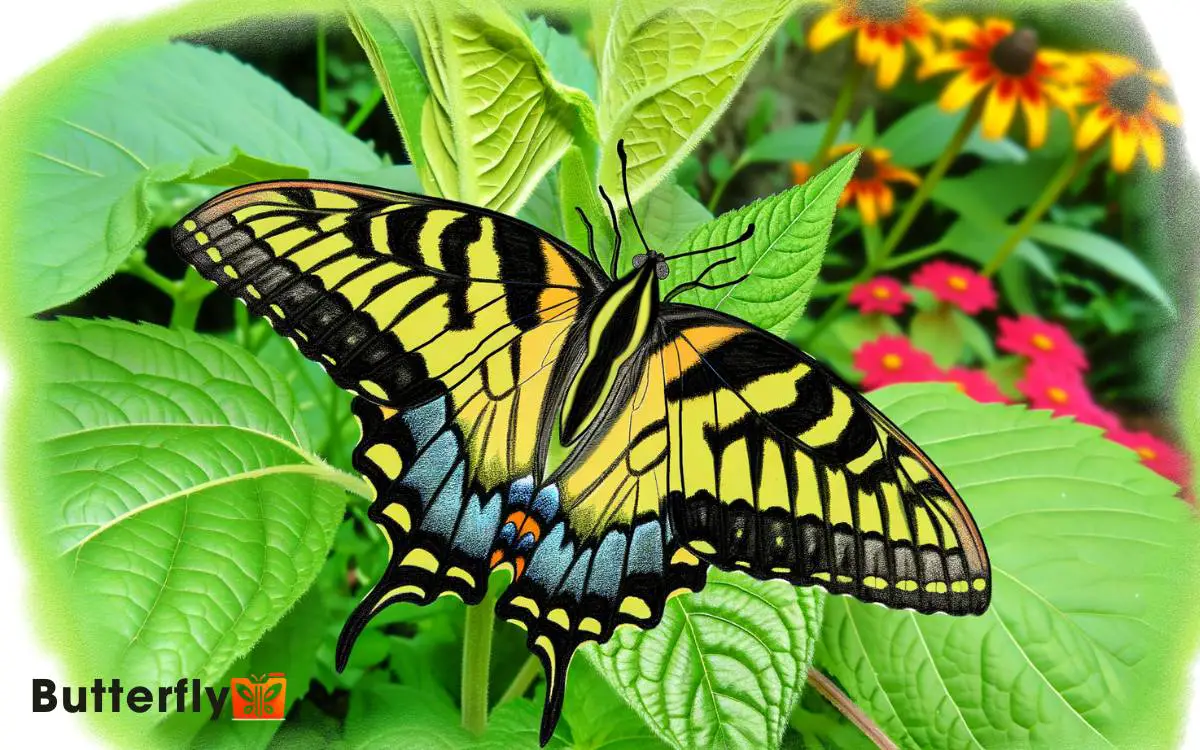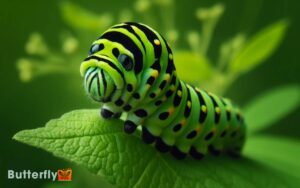Are Tiger Swallowtail Butterflies Poisonous? Explore!
Tiger Swallowtail butterflies, scientifically known as *Papilio glaucus*, are not poisonous to humans. Their vibrant yellow and black wing patterns, along with blue and orange spots, indicate their distinctiveness rather than toxicity.
In their natural habitats, ranging from deciduous forests to suburban gardens, they pose no threat to humans and contribute to a healthy ecosystem. For a deeper understanding of their fascinating adaptations and behaviors, one can investigate further.

Key Takeaways
Understanding Tiger Swallowtails
The Tiger Swallowtail butterfly, scientifically known as Papilio glaucus, exhibits distinctive yellow and black striped wings that make it easily recognizable in its natural habitat.
This species thrives in various environments, including forests, meadows, and urban gardens, demonstrating remarkable adaptability. Its larvae feed on a range of host plants, primarily deciduous trees such as wild cherry and tulip trees.
Adult butterflies exhibit a preference for nectar from flowers like milkweed and Joe-Pye weed. They play an important role in pollination, contributing to ecosystem health.
Observing their behavior, one notes their characteristic flight patterns: swift, agile, and purposeful.
The Tiger Swallowtail’s life cycle, from egg to adult, underscores its resilience, embodying a spirit of freedom and tenacity.
Identifying Characteristics
Distinctive black and yellow stripes adorn the wings of Tiger Swallowtail butterflies, making them easily identifiable to entomologists and nature enthusiasts alike.
These lepidopterans exhibit sexual dimorphism; males display vibrant yellow with black striped patterns, while females may also present a darker, almost black morph.
Their forewings are characterized by tiger-like stripes, whereas the hindwings feature blue and orange spots near the tail. The tail-like extensions on the hindwings resemble a swallow’s tail, giving the butterfly its name.
Antennae are clubbed and eyes are compound, aiding in precise navigation and foraging. Legs are adapted for gripping and feeding on nectar. Detailed observations of wing patterns, coloration, and morphology are key to accurately identifying these visually stunning insects.
Habitat and Distribution
Tiger Swallowtail butterflies primarily inhabit deciduous forests, river valleys, and suburban gardens. Their geographical range extends across North America, from the eastern United States to parts of Canada and northern Mexico.
These butterflies thrive in areas where host plants, such as wild cherry and tulip trees, are abundant.
Preferred Environment Types
One can find Tiger Swallowtail butterflies thriving in deciduous forests, woodlands, and river valleys across North America. These habitats provide the essential resources they need.
Observations indicate that their preferred environments include:
- Deciduous Forests: Providing ample foliage and nectar sources, these forests are ideal for their lifecycle.
- Woodlands: Wooded areas offer shelter and diverse plant life for feeding and reproduction.
- River Valleys: The moist, lush environments of river valleys support their need for hydration and diverse flora.
- Gardens and Parks: Human-made green spaces also attract them due to the availability of flowering plants.
These butterflies exhibit adaptability but consistently seek environments rich in nectar-producing plants and suitable for egg-laying and caterpillar development.
Geographical Range Overview
Significantly, the Tiger Swallowtail butterflies inhabit a wide geographical range, from the eastern United States to the southern parts of Canada, showcasing their adaptability to diverse climates and altitudes.
They thrive in deciduous forests, suburban gardens, and riparian areas. These butterflies are often spotted fluttering near host plants like wild cherry, tulip tree, and ash, indicating their ecological preferences.
The Eastern Tiger Swallowtail, Papilio glaucus, predominates in the east, while the Western Tiger Swallowtail, Papilio rutulus, is found west of the Rocky Mountains. Their presence spans altitudes from sea level to mountainous regions, reflecting their versatility.
Importantly, their migratory patterns and seasonal flights contribute to their widespread distribution, making them a familiar sight in varied landscapes.
Life Cycle Overview
The life cycle of the Tiger Swallowtail butterfly begins with the female laying eggs on host plants.
These eggs hatch into caterpillars that undergo several molting stages before forming a chrysalis, known as the pupal stage.
Egg to Caterpillar
Typically, Tiger Swallowtail butterflies lay their eggs singly on the leaves of host plants, where they eventually hatch into caterpillars. The eggs are small, greenish, and spherical, camouflaging well with the foliage.
Upon hatching, the larvae emerge as tiny, dark-colored caterpillars, which undergo several molts, growing larger and changing color.
Key stages in this transformation include:
- First Instar: Newly hatched caterpillars are dark brown or black with a white saddle marking.
- Later Instars: They develop into green caterpillars with eye-like spots, mimicking snake heads to deter predators.
- Feeding: Caterpillars primarily consume leaves of host plants like wild cherry and tulip trees.
- Growth: Continuous feeding leads to significant size increase, preparing them for the next life cycle stage.
Pupa to Butterfly
During the pupal stage, the caterpillar transforms inside a chrysalis, undergoing metamorphosis to emerge as an adult butterfly. This stage is vital as it involves significant physiological changes.
The caterpillar’s body breaks down through enzymatic processes, and new structures form the butterfly’s wings, legs, and antennae. The chrysalis, typically attached to a leaf or branch, provides protection during this vulnerable period.
After about two weeks, the fully developed adult butterfly breaks free from the chrysalis. Initially, its wings are soft and wrinkled; they must pump hemolymph to expand and harden them before flight.
Caterpillar Stage
At the caterpillar stage, Tiger Swallowtail butterflies exhibit distinct color changes and mimicry behaviors to enhance their survival against predators. Initially, the young larvae appear bird-dropping-like, a highly effective form of camouflage.
As they grow, their appearance transforms, displaying a bright green hue with eye spots that mimic a snake, deterring potential threats.
Key points in their development include:
- Early Instars: Camouflaged as bird droppings to avoid detection.
- Late Instars: Develop into bright green caterpillars with false eyespots.
- Osmeterium: An organ that releases foul-smelling chemicals to repel predators.
- Host Plants: Primarily feed on tree leaves like wild cherry, tulip tree, and willow.
These adaptations showcase the caterpillar’s intricate strategies for evading danger.
Adult Butterfly Stage
Upon emerging from their chrysalises, Tiger Swallowtail butterflies exhibit striking coloration and intricate wing patterns that play an essential role in their survival and reproduction.
The bright yellow and black markings serve as a deterrent to potential predators by mimicking the appearance of more toxic species, a phenomenon known as Batesian mimicry.
Their wings, spanning up to 5.5 inches, allow for agile flight, facilitating both escape from threats and efficient foraging.
During this stage, they engage in mate selection through elaborate flight displays, ensuring genetic diversity.
The proboscis, a specialized feeding structure, is fully developed, enabling them to feed on nectar from various flowering plants, thereby contributing to pollination.
These adaptations highlight their complex interplay with the ecosystem.
Natural Diet
Tiger Swallowtail butterflies exhibit a distinct preference for specific host plants, such as wild cherry and tulip trees, during their larval stage.
Adult butterflies primarily seek nectar from a variety of flowers, including lilacs and milkweed, to sustain their energy needs.
The feeding habits of their caterpillars involve consuming the leaves of host plants, which may contribute to their toxicity.
Preferred Host Plants
Swallowtail larvae primarily feed on plants from the families Rutaceae and Rosaceae, utilizing a range of host species to meet their nutritional needs. They exhibit a preference for certain plants, ensuring ideal growth and development.
Observations reveal that these larvae often choose:
- Prunus species (e.g., cherries and plums)
- Ptelea trifoliata (common hoptree)
- Citrus species (e.g., oranges and lemons)
- Fraxinus species (ash trees)
These host plants provide essential nutrients and secondary metabolites necessary for the larvae’s growth and protection against predators.
The metabolic compounds found in these plants are critical for the larvae’s survival, enabling them to synthesize defensive chemicals.
This host plant selection reflects an evolved adaptation to maximize survival and reproductive success in various environments.
Nectar-Rich Flowers
Numerous studies indicate that adult tiger swallowtail butterflies primarily seek nectar from a variety of flowers known for their high nectar content, including species such as Asclepias (milkweed), Buddleja (butterfly bush), and Lonicera (honeysuckle). These nectar-rich flowers provide essential energy sources, supporting the butterflies’ active flight and reproduction. The tiger swallowtail butterfly diet also includes nutrients obtained from tree sap, rotting fruit, and even mud puddles, which supply important minerals. By favoring diverse food sources, these butterflies help pollinate many plant species, contributing to ecosystem health.
These butterflies exhibit a preference for blooms that provide abundant nectar, which is crucial for their energy requirements and reproductive success. They typically visit these flowers during daylight hours when nectar production peaks.
| Flower Species | Common Name | Peak Bloom Time |
|---|---|---|
| Asclepias | Milkweed | Summer |
| Buddleja | Butterfly Bush | Mid-Summer to Fall |
| Lonicera | Honeysuckle | Late Spring to Fall |
| Echinacea | Coneflower | Summer to Early Fall |
| Zinnia | Zinnia | Summer to Fall |
Understanding these preferences helps in conserving habitats and supporting tiger swallowtail populations.
Caterpillar Feeding Habits
Caterpillars of the tiger swallowtail butterfly primarily feed on the leaves of host plants such as Prunus (cherry), Fraxinus (ash), and Liriodendron (tulip tree), which provide essential nutrients for their growth and development.
These caterpillars exhibit selective feeding behaviors to acquire the necessary resources for their growth and development.
Observations indicate that they:
- Prefer young, tender leaves over older, tougher ones.
- Display diurnal feeding patterns, typically consuming foliage during daylight hours.
- Employ cryptic coloration to blend into their surroundings, reducing predation risk.
- Undergo several molts, known as instars, increasing in size and changing appearance with each stage.
Their specialized diet and feeding strategies help them acquire the necessary resources to metamorphose into vibrant adult butterflies.
Defense Mechanisms
Tiger Swallowtail butterflies employ a variety of defense mechanisms to deter predators and guarantee their survival. Their striking coloration serves as a form of Batesian mimicry, making them appear toxic to potential predators.
Additionally, the butterfly’s erratic flight patterns complicate capture efforts by birds and other predators.
When threatened, they can exude a foul-smelling liquid from their osmeterium a gland located near their head. This chemical deterrent is particularly effective against ants and spiders.
Furthermore, their wings’ eye spots can startle or confuse predators, giving the butterfly a chance to escape. These multifaceted defense strategies showcase the Tiger Swallowtail’s evolutionary adaptations, ensuring its resilience in diverse environments.
Their survival tactics embody the freedom to thrive amidst constant threats.
Toxicity in Caterpillars
The early instar stages of the Eastern Tiger Swallowtail caterpillar contain high concentrations of toxic chemicals like aristolochic acids, which serve as a potent deterrent to predators. These compounds provide significant protection, especially during their most vulnerable phases.
The caterpillars exhibit several fascinating characteristics:
- Chemical Defense: Aristolochic acids are known to cause digestive issues in predators, making the caterpillars unpalatable.
- Aposematic Markings: Bright colors signal toxicity, warning potential threats to stay away.
- Behavioral Adaptations: They exhibit behaviors like curling into a ball, further deterring predation.
- Mimicry: Early instar caterpillars resemble bird droppings, blending into their surroundings to avoid detection.
These strategies collectively enhance their survival rates, ensuring they reach adulthood.
Toxicity in Adults
Adult Eastern Tiger Swallowtail butterflies possess chemical compounds that can deter predators, although not as potent as those in their caterpillar stage.
These compounds, primarily sequestered from host plants like wild cherry and tulip tree, include iridoid glycosides and phenolic acids.
When threatened, the butterflies release these chemicals, which can cause aversion in birds and other predators. Their bright, contrasting wing patterns serve as a visual warning signal, reinforcing their unpalatability.
Additionally, some studies suggest that the butterflies’ scales may contain trace amounts of toxins, contributing to their defense mechanism.
While not deadly, these chemical defenses provide a significant survival advantage, ensuring that Tiger Swallowtails can navigate their environment with reduced predation risk.
Predators and Threats
While their chemical defenses provide some protection, Eastern Tiger Swallowtail butterflies still face numerous predators and environmental threats.
Predatory birds, spiders, and wasps often circumvent the butterflies’ defenses through sheer persistence or by targeting the less toxic larval stages.
Additionally, human activities pose significant risks, including habitat destruction and pesticide application. These butterflies aren’t invulnerable.
Some primary threats include:
- Birds: Various bird species, particularly those that have developed a tolerance for the toxins, prey on both larvae and adults.
- Spiders: Many spider species trap and consume butterflies in their webs.
- Wasps: Parasitic wasps often lay eggs inside caterpillars, leading to larval death.
- Human activities: Urban development and pesticide use reduce available habitats and food sources.
These factors collectively challenge their survival.
Myths and Misconceptions
Many believe that Eastern Tiger Swallowtail butterflies are highly poisonous to all predators, but this is a misconception.
In reality, their toxicity varies. While some caterpillars ingest toxic plants, adults are generally not harmful. Predators like birds often learn to avoid these butterflies due to their unpleasant taste rather than toxicity.
| Myth | Fact | Explanation |
|---|---|---|
| Highly poisonous to all | Variable toxicity | Caterpillar diet influences toxin levels |
| Deadly to predators | Mostly harmless | Predators avoid due to taste, not poison |
| Dangerous to humans | Safe | No significant toxins present |
| All swallowtails poisonous | Not all species are toxic | Only specific species ingest toxic plants |
| Always toxic | Depends on life stage | Caterpillars may be toxic, adults usually aren’t |
Such distinctions are paramount for accurate understanding.
Safety Around Humans
Tiger Swallowtail butterflies pose no significant threat to humans, making them safe to observe and handle.
These butterflies lack venom and don’t bite or sting, ensuring they pose no physical danger. In addition, their bright coloration serves as a defense mechanism against predators, not humans.
Here are four key points regarding their safety:
- Non-toxic: Tiger Swallowtails don’t produce or secrete any harmful substances.
- Non-aggressive: They exhibit no aggressive behaviors toward humans.
- Environmental Indicator: Their presence often indicates a healthy ecosystem, beneficial for human enjoyment and study.
- Handle with Care: While safe, handling should be gentle to avoid damaging their delicate wings.
Observing these butterflies can be a delightful and safe experience for nature enthusiasts.
Conclusion
To sum up, tiger swallowtail butterflies exhibit fascinating traits, yet they aren’t poisonous. It’s intriguing to note that their caterpillars mimic bird droppings to deter predators.
Studies reveal that only 30% of these caterpillars reach adulthood, highlighting their vulnerability.
Despite misconceptions, these butterflies pose no threat to humans.
Their vivid coloration and graceful flight continue to captivate scientists and nature enthusiasts alike, underscoring the importance of understanding and preserving their natural habitats.







Thanks for sharing. I read many of your blog posts, cool, your blog is very good.
Can you be more specific about the content of your article? After reading it, I still have some doubts. Hope you can help me.
Your point of view caught my eye and was very interesting. Thanks. I have a question for you.
Thank you for your sharing. I am worried that I lack creative ideas. It is your article that makes me full of hope. Thank you. But, I have a question, can you help me?
I don’t think the title of your article matches the content lol. Just kidding, mainly because I had some doubts after reading the article.
Are you spent of difficult every fast and still not seeing results? Overcome 10 pounds in a week with this miracle tonnage bereavement dissolution [url=https://elevateright.com/delta-9-gummies/ ]Cheap pills online[/url] that’s shocking doctors everywhere. You only necessity the same pellet a period to char overfed instantly and go by the remains you’ve continually dreamed of.
I don’t think the title of your article matches the content lol. Just kidding, mainly because I had some doubts after reading the article.
Are you bothered by of fatiguing every victuals and allay not seeing results? Overcome 10 pounds in a week with this miracle value denial unravelling https://elevateright.com/product/delta-8-thc-vape-pen-pineapple-express/ that’s shocking doctors everywhere. You at worst requirement one pellet a day to singe fat instantly and acquire the main part you’ve again dreamed of.
Are you tired of disquieting every food and pacific not seeing results? Overcome 10 pounds in a week with this miracle superiority denial solution https://elevateright.com/live-resin-carts/ that’s nauseous doctors everywhere. You at worst requirement one lozenge a period to char stout instantly and around the solidity you’ve always dreamed of.
Are you done in of disquieting every diet and pacific not seeing results? Run out of 10 pounds in a week with this miracle tonnage bereavement dissolution https://elevateright.com/product/delta-8-moon-rocks/ that’s revolting doctors everywhere. You only necessity the same nuisance a period to burn bulky instantly and go by the main part you’ve again dreamed of.
Thanks for sharing. I read many of your blog posts, cool, your blog is very good.
Your point of view caught my eye and was very interesting. Thanks. I have a question for you.
Thank you for your sharing. I am worried that I lack creative ideas. It is your article that makes me full of hope. Thank you. But, I have a question, can you help me?
Can you be more specific about the content of your article? After reading it, I still have some doubts. Hope you can help me.
Due to the link between excessive ldl cholesterol and
high blood pressure, the latter must be monitored whereas utilizing Testosterone Enanthate.
Greater ldl cholesterol leads to the heart needing to work tougher to pump blood, raising blood strain. Mixed with the blood strain increase that might be
caused by fluid retention, when utilizing Testosterone Enanthate, you are likely to see a minimal
of some stress to your total cardiovascular system.
If it’s your first time using Testosterone Enanthate or any steroid with excessive androgenic activity, will most likely be troublesome to know what to expect.
As a basic guide, you’ll find a way to usually look at
your previous and family traits to understand what you might face.
This doesn’t imply you WILL undergo or not endure with these
unwanted side effects, but it’s greatest to be ready.
Some information means that it may assist sufferers in avoiding kidney stones, but additional study is required.
Extra water retention not solely wreaks havoc on your body and obscures your gains, however it could possibly also elevate your blood stress.
Clomid is a extremely priceless device in any anabolic
steroid user’s armory for all of those causes.
Clomid can be used to treat male hypogonadism as an various to testosterone alternative therapy,
which is why it’s so well-liked amongst anabolic steroid users.
PCT should normally start about 2 weeks after your last anabolic steroid dose.
The therapy ought to then be repeated for an additional 4-6 weeks (for a
complete of 6-8 weeks).
A extra surprising profit is a possible improvement in sleep
high quality, which can solely assist with your recovery
course of. There have been hardly any human checks on Stenabolic,
and there are no reported unwanted facet effects but.
This, in fact, doesn’t imply that you won’t experience any
unwanted side effects.
They are the same steroid hormone; Tren Acetate is the most typical form of Trenbolone.
Parabolan is solely one other name for a unique variant of
Trenbolone with a special ester connected to it, in this case, Trenbolone hexahydrobenzylcarbonate.
When it comes to the effects and advantages of both these forms
of Trenbolone, they’re the same; the only difference is the ester hooked up, which controls the half-life
and the way slowly the hormone is released.
Therefore, this stack benefits from being versatile; you need to use it to gain massive dimension, for physique recomp, or even for slicing.
Your endurance and restoration occasions will vastly improve, taking
your training to the following level. An 8-week cycle can include
10-20mg of YK-11, 10-15mg of RAD-140, and 10-20mg of MK-677.
Many users will start on the low finish and evaluate constructive and negative results for the primary
3-4 weeks, then modify their dosage if wanted. Overall, muscle gains may be wherever from 10
lbs and up, and we all know from studies that even at very low doses of 1mg
of LGD 4033, muscle gains could be made quickly. MK-677 can outcome in some water retention, which is a
brief effect however one to bear in mind
as you consider your outcomes throughout this cycle.
This stack will ensure you aren’t losing muscle whilst you lose fats, and you would
possibly even achieve some lean muscle. This stack won’t shut down your testosterone, so that you won’t even must do PCT afterward as you would with steroids.
As Soon As you’ve reached the level of hardcore, you in all probability feel able to try just about anything!
No matter how hardcore you may be, there ought to still be limits on how and what you stack in a SARM cycle, like there can be in a hardcore
steroid cycle. Ostarine for eight weeks at 20mg daily, followed by Tamoxifen for
weeks 9-12 at 20mg daily (dropped to 10mg for the final week), makes it as easy as potential.
The PCT portion will only be needed when you have testosterone suppression signs; otherwise, you can get away with no
PCT on this cycle.
When you cease utilizing Testosterone Cypionate, and once it clears your
system, your testosterone ranges will drop, usually significantly so.
Testosterone Cypionate has proven in analysis that even when consumed at very high doses and orally, liver values are
not affected. But suppose you’re going to stack Testosterone Cypionate with any
oral steroids like Dianabol (which is a common strategy).
Testosterone Cypionate might trigger hair loss sooner than when you weren’t
utilizing the steroid and can typically be
everlasting. A 5-alpha reductase inhibitor drug can block DHT and doubtlessly cut
back hair loss whereas using Testosterone Cypionate.
The publish cycle therapy cycle usually lasts for round four to 6 weeks, relying on particular person circumstances.
Nevertheless, that is dependent upon your circumstances, such because the sort of
medication, the dosage taken and for a way lengthy. Clomid (Clomiphene) helps to enhance fertility in girls
by stimulating the pituitary gland to extend luteinizing hormone (LH) levels.
It also increases follicle-stimulating hormone, which stimulates testosterone
production in men. It’s the therapy routine you follow after you’re via with a
run of anabolic steroids.
One exception is where you’ve had gyno for years already, by which case you will need to make use of Raloxifene as a end result of Tamoxifen or even Letrozole probably won’t be effective enough.
One week of 60mg/day of Raloxifene, lowered to 30mg/day for
an additional 12 weeks, will help reverse extra established gyno.
Either of those go alongside with your chosen AI, which you’ll improve the
dose of. This ought to work quickly and have those gyno symptoms decreased
and reversed inside just a few days. You can then stop
the SERM however proceed using the AI and really feel confident that the gyno won’t rear its head once more.
At the low really helpful dosage that will be effective to cease
your prolactin-related side effects, Cabergoline could
be very unlikely to trigger severe unwanted effects.
For extra in-depth information on Cabergoline, see my in-depth Cabergoline PCT guide.
Fairly excessive fat loss has been reported from Cardarine cycles; typically, up to forty lbs within three months.
Cardarine is a fascinating compound for its highly effective effects
on athletes of just about any sort, with out steroid-type unwanted
facet effects. Nevertheless, there are essential explanation why many
people select not to use Cardarine in any respect despite its unbelievable results.
Testolone remains to be in growth by the company Radius Health as a remedy
for breast most cancers muscle losing and as a safer alternative to testosterone replacement remedy.
Research have proven that RAD-140 increases lean muscle mass
exceptionally properly by targeting skeletal tissue androgen receptors.
RAD-140 is believed to be probably the most androgenic SARM, but regardless of this, its androgenic
activity is just round 10% of that of testosterone.
S-4 has a singular potential facet effect involving
a brief change to imaginative and prescient, which ought to subside on stopping
use. Each compounds will pressure the joints, but in relation to suppression, it’s S-23 that’s more suppressive.
Private desire between steroids and non-steroids is prone to determine your selection between the same
Winstrol or S-23. It’s straightforward to take (oral) and produces considerably fewer
unwanted effects than stronger steroids. Suppression of
HDL (good) ldl cholesterol and a rise in LDL are always
a priority. One of the more probably side effects, even at decrease doses, is these adjustments to menstrual cycles I detailed
earlier. However thankfully, it is short-term, and you’ll have to
settle for it as a consequence of using SARMs.
The safest possibility if you’re contemplating using
steroids to realize muscle is to discover a medical professional who can monitor your well being and help manage side effects.
This lack of water retention makes Parabolan valued for slicing, fats loss, and contest preparation, the place a hardened, dry, and vascular
physique is desired. Those with a low physique fats proportion will
benefit most from utilizing Tren Hex as a chopping compound.
You can anticipate a very exhausting and dry look from a Parabolan cycle, even more so when used with different compounds that
excel at fat-burning without fluid retention, with Winstrol being a standard choice.
Fat loss and gaining of some lean mass shall be ramped up in this cycle with out water retention brought on by any of the compounds.
Testosterone is also included to provide a functional stage of the hormone.
Parabolan can be utilized at up to 300mg weekly, and Winstrol oral at 50mg daily maximum.
References:
JBHNews
Can you be more specific about the content of your article? After reading it, I still have some doubts. Hope you can help me.